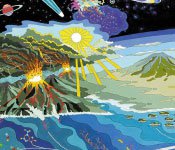
Iron formations (IF) are iron rich (~20-40% Fe) and siliceous (~40-50% SiO2) marine sedimentary deposits that precipitated throughout much of the Precambrian. Recently, their trace element compositions have been used to determine paleo-seawater chemistry, with the ultimate goal being to better understanding nutrient availability for the ancient marine biosphere. Three examples are provided here. First, low phosphorous concentrations in Archean and Paleoproterozoic IF have been linked to reduced levels of oxygenic photosynthesis at that time, which had the effect of limiting O2 production until around 2.4 billion years ago, the so-called Great Oxidation Event (GOE). A subsequent increase in P content of IF in the Neoproterozoic, following Snowball Earth deglaciations, may then have led to a second episode of enhanced cyanobacterial photosynthesis, which in turn, produced enough oxygen to facilitate the evolution of animal life. Second, it has been shown that the nickel content in IF has changed dramatically over time, and that a drop in Ni availability in the oceans around 2.7 billion years ago would have had profound consequences for microorganisms that depended on it, that being methane-producing bacteria called methanogens. It is possible that a Ni famine eventually led to a cascade of events that began with reduced methane production, the expansion of cyanobacteria into shallow-water settings previously occupied by methanogens, and ultimately increased oxygenic photosynthesis that tipped the atmospheric balance in favour of oxygen and the GOE. Third, a recent compilation of Cr concentrations in IF shows a profound enrichment coincident with the GOE. Given the insolubility of Cr minerals, its mobilization and incorporation into IF indicates enhanced chemical weathering at that time, most likely associated with the evolution of aerobic bacteria on land.
 A Talk With Jim Green
A Talk With Jim Green What Can Extant Genomes Reveal About Early DNA Metabolism?
What Can Extant Genomes Reveal About Early DNA Metabolism? What We Talk About When We Talk About Earth's Oxygenation
What We Talk About When We Talk About Earth's Oxygenation Bowling With Astrobiologists: A Twisted Path Toward the Origin of DNA
Bowling With Astrobiologists: A Twisted Path Toward the Origin of DNA